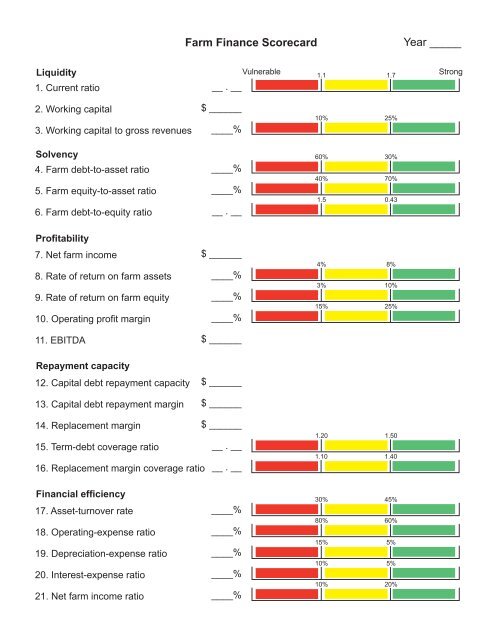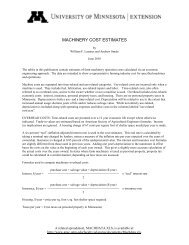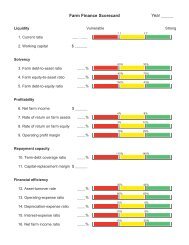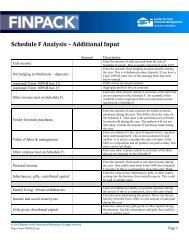Farm Finance Scorecard - Center for Farm Financial Management
Farm Finance Scorecard - Center for Farm Financial Management
Farm Finance Scorecard - Center for Farm Financial Management
You also want an ePaper? Increase the reach of your titles
YUMPU automatically turns print PDFs into web optimized ePapers that Google loves.
<strong>Farm</strong> <strong>Finance</strong> <strong>Scorecard</strong><br />
Year _____<br />
Liquidity<br />
1. Current ratio<br />
Vulnerable<br />
__ . __<br />
1.1 1.7<br />
Strong<br />
2. Working capital<br />
3. Working capital to gross revenues<br />
$ ______<br />
____%<br />
10% 25%<br />
Solvency<br />
4. <strong>Farm</strong> debt-to-asset ratio<br />
5. <strong>Farm</strong> equity-to-asset ratio<br />
6. <strong>Farm</strong> debt-to-equity ratio<br />
____%<br />
____%<br />
__ . __<br />
60% 30%<br />
40% 70%<br />
1.5 0.43<br />
Profitability<br />
7. Net farm income<br />
8. Rate of return on farm assets<br />
9. Rate of return on farm equity<br />
10. Operating profi t margin<br />
$ ______<br />
____%<br />
____%<br />
____%<br />
4% 8%<br />
3% 10%<br />
15% 25%<br />
11. EBITDA<br />
$ ______<br />
Repayment capacity<br />
12. Capital debt repayment capacity<br />
$ ______<br />
13. Capital debt repayment margin<br />
$ ______<br />
14. Replacement margin<br />
15. Term-debt coverage ratio<br />
$ ______<br />
__ . __<br />
16. Replacement margin coverage ratio __ . __<br />
1.20 1.50<br />
1.10 1.40<br />
<strong>Financial</strong> efficiency<br />
17. Asset-turnover rate<br />
18. Operating-expense ratio<br />
19. Depreciation-expense ratio<br />
20. Interest-expense ratio<br />
21. Net farm income ratio<br />
____%<br />
____%<br />
____%<br />
____%<br />
____%<br />
30% 45%<br />
80% 60%<br />
15% 5%<br />
10% 5%<br />
10% 20%
Liquidity<br />
- is the ability of your farm business to<br />
meet financial obligations as they come<br />
due – to generate enough cash to pay<br />
your family living expenses and taxes, and<br />
make debt payments on time.<br />
1. Current ratio<br />
- measures the extent to which current<br />
farm assets, if sold tomorrow, would pay<br />
off current farm liabilities.<br />
2. Working capital<br />
- tells us the operating capital available<br />
in the short term from within the business.<br />
3. Working capital to gross revenues<br />
- measures operating capital available<br />
against the size of the business.<br />
Solvency<br />
- is the ability of your business to pay all its<br />
debts if it were sold tomorrow. Solvency<br />
is important in evaluating the financial risk<br />
and borrowing capacity of the business.<br />
Profitability<br />
- is the difference between the value<br />
of goods produced and the cost of the<br />
resources used in their production.<br />
7. Net farm income<br />
- represents return to 3 things,<br />
• Your labor,<br />
• Your management and<br />
• Your equity,<br />
that you have invested in the business.<br />
It is the reward <strong>for</strong> investing your<br />
unpaid family labor, management<br />
and money in the business instead of<br />
elsewhere. Anything left in the<br />
business, i.e., not taken out <strong>for</strong> family<br />
living and taxes, will increase your farm<br />
net worth.<br />
8. Rate of return on farm assets<br />
- can be thought of as the average<br />
interest rate being earned on all (yours<br />
and creditors’) investments in the farm.<br />
Unpaid labor and management are<br />
assigned a return be<strong>for</strong>e return on farm<br />
assets is calculated.<br />
<strong>Farm</strong> <strong>Financial</strong> Ratios and Guidelines<br />
From the balance sheet<br />
From the income statement<br />
2<br />
4. <strong>Farm</strong> debt-to-asset ratio<br />
- is the bank’s share of the business.<br />
It compares total farm debt to total<br />
farm assets. A higher ratio is an<br />
indicator of greater financial risk and<br />
lower borrowing capacity.<br />
5. <strong>Farm</strong> equity-to-asset ratio<br />
- is your share of the business. It<br />
compares farm equity to total farm<br />
assets. If you add the debt-to-asset<br />
ratio and the equity-to-asset ratio you<br />
must get 100%.<br />
6. <strong>Farm</strong> debt-to-equity ratio<br />
- compares the bank’s ownership to<br />
your ownership. It also indicates how<br />
much the owners have leveraged (i.e.,<br />
multiplied) their equity in the business.<br />
9. Rate of return on farm equity<br />
- represents the interest rate being<br />
earned by your investment in the farm.<br />
This return can be compared to<br />
returns available if your equity were<br />
invested somewhere else, such as a<br />
certificate of deposit.<br />
10. Operating profit margin<br />
- shows the operating efficiency of the<br />
business. If expenses are low relative<br />
to the value of farm production, the<br />
business will have a healthy operating<br />
profit margin. A low profit margin<br />
can be caused by low product prices,<br />
high operating expenses, or inefficient<br />
production.<br />
11. EBITDA<br />
- Earnings Be<strong>for</strong>e Interest Taxes<br />
Depreciation and Amortization.<br />
Measures earnings available <strong>for</strong> debt<br />
repayment.
Repayment capacity<br />
- shows the borrower’s (i.e., your) ability to<br />
repay term debts on time. It includes nonfarm<br />
income and so is not a measure of<br />
business per<strong>for</strong>mance alone.<br />
12. Capital debt repayment capacity<br />
- measures the amount generated from<br />
farm and non-farm sources, to cover debt<br />
repayment and capital replacement.<br />
13. Capital debt repayment margin<br />
- is the amount of money remaining after<br />
all operating expenses, taxes, family living<br />
costs, and scheduled debt payments have<br />
been made. It’s really the money left,<br />
after paying all bills, that is available <strong>for</strong><br />
purchasing or financing new machinery,<br />
equipment, land or livestock.<br />
From the cash-flow statement<br />
14. Replacement margin<br />
- the amount of income remaining after<br />
paying principal and interest on term<br />
loans and unfunded (cash) capital<br />
purchases.<br />
15. Term-debt coverage ratio<br />
- tells whether your business produced<br />
enough income to cover all intermediate<br />
and long-term debt payments. A ratio<br />
of less than 1.0 indicates that the<br />
business had to liquidate inventories,<br />
run up open accounts, borrow money, or<br />
sell assets to make scheduled payments.<br />
16. Replacement margin coverage ratio<br />
- A ratio under 1.0 indicates that you did<br />
not generate enough income to cover<br />
term debt payments and unfunded<br />
capital purchases.<br />
<strong>Financial</strong> efficiency<br />
- shows how effectively your business uses<br />
assets to generate income. Past<br />
per<strong>for</strong>mance of the business could well<br />
indicate potential future accomplishments.<br />
It also answers the questions:<br />
• Are you using every available asset to<br />
its fullest potential?<br />
From all the financial statements<br />
The last four ratios show how Gross <strong>Farm</strong><br />
Income is used. The sum of the four equals<br />
100% (of Gross <strong>Farm</strong> Income).<br />
18. Operating-expense ratio<br />
- shows the proportion of farm income<br />
that is used to pay operating expenses,<br />
not including principal or interest.<br />
• What are the effects of production,<br />
purchasing, pricing, financing and<br />
marketing decisions on gross income?<br />
17. Asset-turnover rate<br />
- measures efficiency in using capital.<br />
You could think of it as capital productivity.<br />
Generating a high level of production with<br />
a low level of capital investment will give<br />
a high asset-turnover rate. If, on the other<br />
hand, the turnover is low you will want to<br />
explore methods to use the capital<br />
invested much more efficiently or sell<br />
some low-return investments. (It could<br />
mean getting rid of that swamp and ledge<br />
on the back 40 and getting something<br />
that produces income.)<br />
19. Depreciation-expense ratio<br />
- indicates how fast the business wears<br />
out capital. It tells what proportion of<br />
farm income is needed to maintain the<br />
capital used by the business.<br />
20. Interest-expense ratio<br />
- shows how much of gross farm income<br />
is used to pay <strong>for</strong> interest on borrowed<br />
capital.<br />
21. Net farm income ratio<br />
- compares profit to gross farm income.<br />
It shows how much is left after all farm<br />
expenses, except <strong>for</strong> unpaid labor and<br />
management, are paid.<br />
3
Liquidity<br />
1. Current ratio<br />
= Total current farm assets<br />
/ Total current farm liabilities<br />
2. Working capital<br />
= Total current farm assets<br />
– Total current farm liabilities<br />
3. Working capital to gross revenues<br />
= Working capital / Gross farm income<br />
Solvency (market)<br />
4. <strong>Farm</strong> debt-to-asset ratio<br />
= Total farm liabilities / Total farm assets<br />
5. <strong>Farm</strong> equity-to-asset ratio<br />
= <strong>Farm</strong> net worth / Total farm assets<br />
6. <strong>Farm</strong> debt-to-equity ratio<br />
= Total farm liabilities / <strong>Farm</strong> net worth<br />
Profitability<br />
7. Net farm income<br />
= Gross cash farm income<br />
– Total cash farm expense<br />
+ / – Inventory changes<br />
– Depreciation<br />
8. Rate of return on farm assets<br />
= Return on farm assets / Average farm assets<br />
Return on farm assets<br />
= Net farm income<br />
+ <strong>Farm</strong> interest<br />
– Value of operator labor & management<br />
9. Rate of return on farm equity<br />
= Return on farm equity / Average farm net worth<br />
Return on farm equity<br />
= Net farm income<br />
– Value of operator labor & management<br />
10. Operating profit margin<br />
= Return on farm assets<br />
/ Value of farm production<br />
Value of farm production<br />
= Gross cash farm income<br />
+ / – Inv change of crops, mkt lvst,<br />
brdg lvst & other income items<br />
– Feeder livestock purchased<br />
– Purchased feed<br />
11. EBITDA<br />
= Net farm income<br />
+ Interest expense<br />
+ Depreciation and amortization expense<br />
Repayment capacity<br />
12. Capital debt repayment capacity<br />
= Net farm income<br />
+ Depreciation<br />
+ Net non-farm income<br />
– Family living & income taxes<br />
+ Interest expense on term loans<br />
13. Capital debt repayment margin<br />
= Capital debt repayment capacity<br />
– Scheduled principal & interest on term loans*<br />
14. Replacement margin<br />
= Capital debt repayment margin<br />
– Unfunded (cash) capital replacement allowance<br />
15. Term debt coverage ratio<br />
= Capital debt repayment capacity<br />
/ Scheduled principal & interest on term loans*<br />
16. Replacement margin coverage ratio<br />
= Capital debt repayment capacity<br />
/ (Scheduled principal & interest on term loans*<br />
+ Unfunded capital replacement allowance)<br />
<strong>Financial</strong> efficiency<br />
17. Asset-turnover ratio<br />
= Value of farm production<br />
/ Average farm assets<br />
18. Operating-expense ratio<br />
= (Total farm operating expense excluding interest<br />
– Depreciation)<br />
/ Gross farm income<br />
19. Depreciation-expense ratio<br />
= Depreciation<br />
/ Gross farm income<br />
20. Interest-expense ratio<br />
= <strong>Farm</strong> interest<br />
/ Gross farm income<br />
21. Net farm income ratio<br />
= Net farm income<br />
/ Gross farm income<br />
*Includes payments on capital leases<br />
Developed by:<br />
K. Becker,<br />
D. Kauppila,<br />
G. Rogers,<br />
R. Parsons,<br />
D. Nordquist,<br />
and R. Craven<br />
The University of Minnesota is committed to the policy that all persons shall have equal access to its programs, facilities, and employment without regard to race,<br />
color, creed, religion, national origin, sex, age, marital status, disability, public assistance status, veteran status, or sexual orientation.<br />
2009





